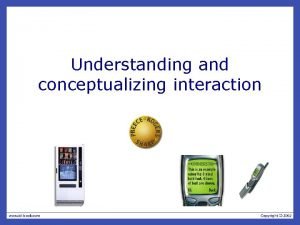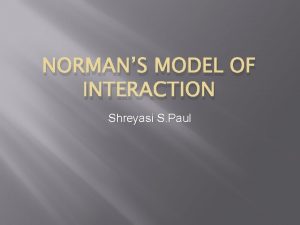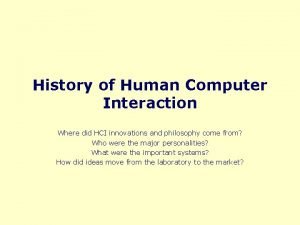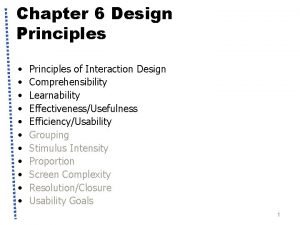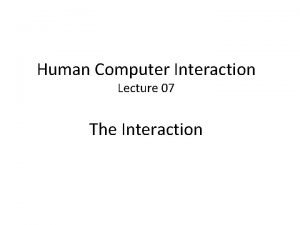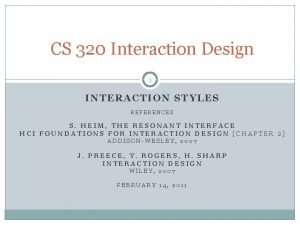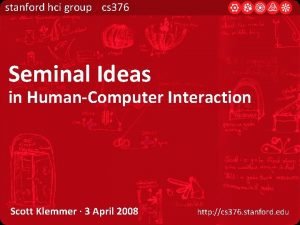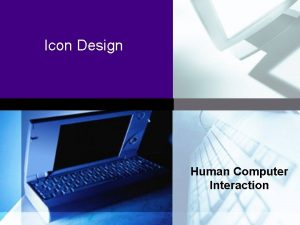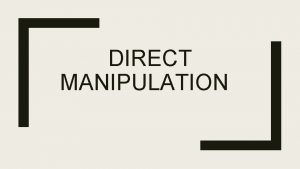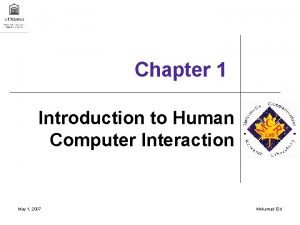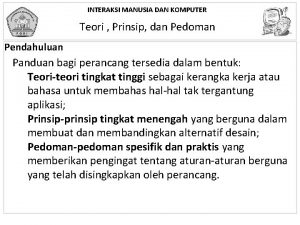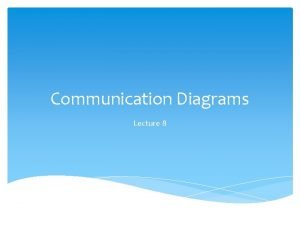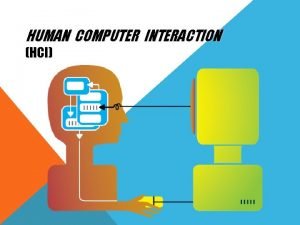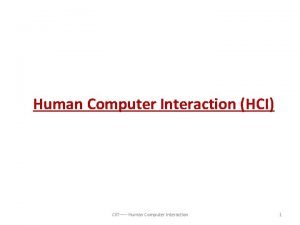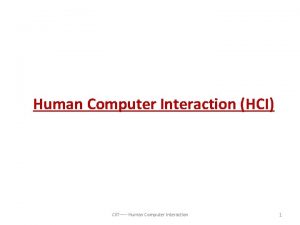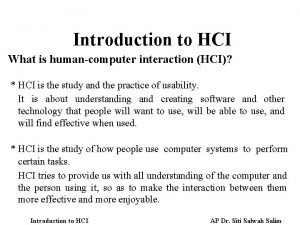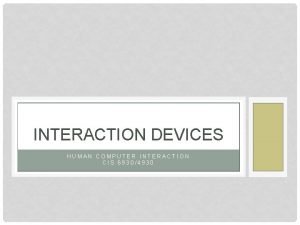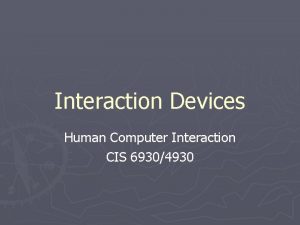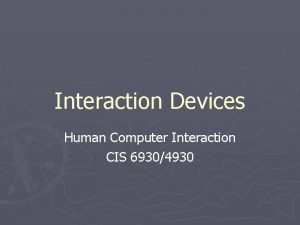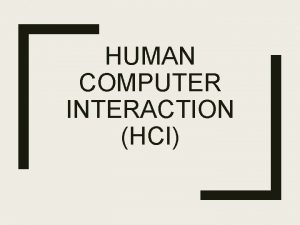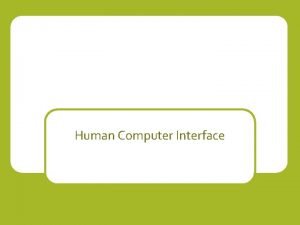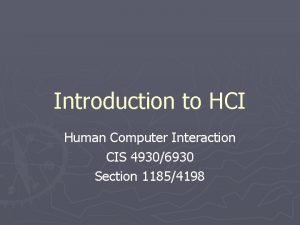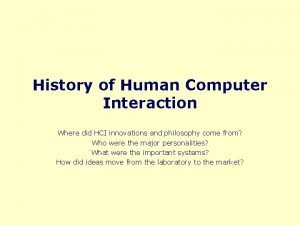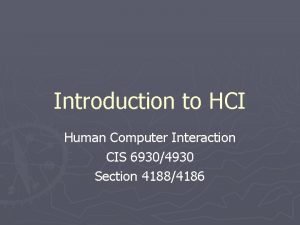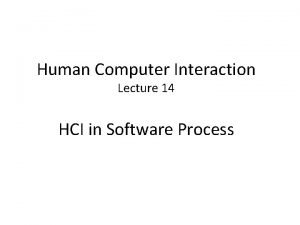HUMAN COMPUTER INTERACTION HCI Human Psychology and Everyday

![Human Psychology and Everyday Things [1] ■ This topic discusses some principles that constitute Human Psychology and Everyday Things [1] ■ This topic discusses some principles that constitute](https://slidetodoc.com/presentation_image/56f9633bac261716952923221a6127dd/image-2.jpg)
![Affordance [1] ■ Affordance is the range of possible (physical) actions by a user Affordance [1] ■ Affordance is the range of possible (physical) actions by a user](https://slidetodoc.com/presentation_image/56f9633bac261716952923221a6127dd/image-3.jpg)
![Zeiss Slide Projector [1] Zeiss Slide Projector [1]](https://slidetodoc.com/presentation_image/56f9633bac261716952923221a6127dd/image-4.jpg)
![Affordance (Cont. ) [1] Affordance in Real World ■ For physical objects, there can Affordance (Cont. ) [1] Affordance in Real World ■ For physical objects, there can](https://slidetodoc.com/presentation_image/56f9633bac261716952923221a6127dd/image-5.jpg)
![Affordance (Cont. ) [1] ■ Example of ambiguous doors design ■ In door (a) Affordance (Cont. ) [1] ■ Example of ambiguous doors design ■ In door (a)](https://slidetodoc.com/presentation_image/56f9633bac261716952923221a6127dd/image-6.jpg)
![Affordance (Cont. ) [1] ■ Example of good doors design ■ In door (a) Affordance (Cont. ) [1] ■ Example of good doors design ■ In door (a)](https://slidetodoc.com/presentation_image/56f9633bac261716952923221a6127dd/image-7.jpg)
![Affordance (Cont. ) [1] ■ Real world examples of badly designed doors ■ Supposed Affordance (Cont. ) [1] ■ Real world examples of badly designed doors ■ Supposed](https://slidetodoc.com/presentation_image/56f9633bac261716952923221a6127dd/image-8.jpg)
![Affordance (cont. ) [1] Typical Computer Hardware and GUI affordances examples 1. Screen affords Affordance (cont. ) [1] Typical Computer Hardware and GUI affordances examples 1. Screen affords](https://slidetodoc.com/presentation_image/56f9633bac261716952923221a6127dd/image-9.jpg)
![Mappings [1] ■ Mappings are the relationship between controls and their effects on the Mappings [1] ■ Mappings are the relationship between controls and their effects on the](https://slidetodoc.com/presentation_image/56f9633bac261716952923221a6127dd/image-10.jpg)
![Mappings (cont. ) [1] Example of natural mappings: ■ Which control is connected to Mappings (cont. ) [1] Example of natural mappings: ■ Which control is connected to](https://slidetodoc.com/presentation_image/56f9633bac261716952923221a6127dd/image-11.jpg)
![Mappings (cont. ) [1] ■ A better mapping but still with 4 combinations Mappings (cont. ) [1] ■ A better mapping but still with 4 combinations](https://slidetodoc.com/presentation_image/56f9633bac261716952923221a6127dd/image-12.jpg)
![Mappings (cont. ) [1] ■ A natural mapping There is no ambiguity, no need Mappings (cont. ) [1] ■ A natural mapping There is no ambiguity, no need](https://slidetodoc.com/presentation_image/56f9633bac261716952923221a6127dd/image-13.jpg)
![Constraints [1] ■ The difficulty of dealing with a novel situation is directly related Constraints [1] ■ The difficulty of dealing with a novel situation is directly related](https://slidetodoc.com/presentation_image/56f9633bac261716952923221a6127dd/image-14.jpg)
![Constraints (cont. ) [1] ■ Example of Lego ■ Motorbike toy with 12 parts. Constraints (cont. ) [1] ■ Example of Lego ■ Motorbike toy with 12 parts.](https://slidetodoc.com/presentation_image/56f9633bac261716952923221a6127dd/image-15.jpg)
![Constraints (cont. ) [1] ■ Physical: Front wheel only fits in one place. ■ Constraints (cont. ) [1] ■ Physical: Front wheel only fits in one place. ■](https://slidetodoc.com/presentation_image/56f9633bac261716952923221a6127dd/image-16.jpg)
![Constraints (cont. ) [1] The assembled Lego Constraints (cont. ) [1] The assembled Lego](https://slidetodoc.com/presentation_image/56f9633bac261716952923221a6127dd/image-17.jpg)
![Constraints [1] Conventions are cultural constraints. They are initially arbitrary, but evolve and become Constraints [1] Conventions are cultural constraints. They are initially arbitrary, but evolve and become](https://slidetodoc.com/presentation_image/56f9633bac261716952923221a6127dd/image-18.jpg)
![Causality [1] Causality is when something which happens right after an action, appears to Causality [1] Causality is when something which happens right after an action, appears to](https://slidetodoc.com/presentation_image/56f9633bac261716952923221a6127dd/image-19.jpg)





![References [1] Lecture Notes of Prof. Keith Andrews, Available at: www. iicm. tugraz. at/hci References [1] Lecture Notes of Prof. Keith Andrews, Available at: www. iicm. tugraz. at/hci](https://slidetodoc.com/presentation_image/56f9633bac261716952923221a6127dd/image-25.jpg)
- Slides: 25

HUMAN COMPUTER INTERACTION (HCI)
![Human Psychology and Everyday Things 1 This topic discusses some principles that constitute Human Psychology and Everyday Things [1] ■ This topic discusses some principles that constitute](https://slidetodoc.com/presentation_image/56f9633bac261716952923221a6127dd/image-2.jpg)
Human Psychology and Everyday Things [1] ■ This topic discusses some principles that constitute the psychology of human beings that “how they interact with everyday things” OR ■ The principles that forms the “mental model” of human beings that how something works These principles include: 1. 2. 3. 4. Affordance Mapping Constraints Causality
![Affordance 1 Affordance is the range of possible physical actions by a user Affordance [1] ■ Affordance is the range of possible (physical) actions by a user](https://slidetodoc.com/presentation_image/56f9633bac261716952923221a6127dd/image-3.jpg)
Affordance [1] ■ Affordance is the range of possible (physical) actions by a user on an object: 1) Perceived Affordance is the set of actions a user perceives to be possible. 2) Real Affordance is the set of actions which are actually possible.
![Zeiss Slide Projector 1 Zeiss Slide Projector [1]](https://slidetodoc.com/presentation_image/56f9633bac261716952923221a6127dd/image-4.jpg)
Zeiss Slide Projector [1]
![Affordance Cont 1 Affordance in Real World For physical objects there can Affordance (Cont. ) [1] Affordance in Real World ■ For physical objects, there can](https://slidetodoc.com/presentation_image/56f9633bac261716952923221a6127dd/image-5.jpg)
Affordance (Cont. ) [1] Affordance in Real World ■ For physical objects, there can be both real and perceived affordances (and the two sets are not necessarily the same). ■ Appearance support affordance and indicates how to use something, for example: 1. A chair affords (suggests) sitting. 2. Knobs are for turning. 3. Slots are for inserting things. 4. A button affords pushing. ■ Perceived affordances are taken advantage through, when the user knows what to do just by looking. ■ According to Donald A. Norman: “When simple things need pictures, labels, or instructions, the design has failed!”
![Affordance Cont 1 Example of ambiguous doors design In door a Affordance (Cont. ) [1] ■ Example of ambiguous doors design ■ In door (a)](https://slidetodoc.com/presentation_image/56f9633bac261716952923221a6127dd/image-6.jpg)
Affordance (Cont. ) [1] ■ Example of ambiguous doors design ■ In door (a) a knob is available for turning but no clue for push or pull. ■ In door (b) a horizontal bar is available but no clue from which side of the bar to push (a) (b)
![Affordance Cont 1 Example of good doors design In door a Affordance (Cont. ) [1] ■ Example of good doors design ■ In door (a)](https://slidetodoc.com/presentation_image/56f9633bac261716952923221a6127dd/image-7.jpg)
Affordance (Cont. ) [1] ■ Example of good doors design ■ In door (a) a vertical bar affords grasping and pulling. ■ In door (b) the broadness of the bar indicates push and which side to push (a) (b)
![Affordance Cont 1 Real world examples of badly designed doors Supposed Affordance (Cont. ) [1] ■ Real world examples of badly designed doors ■ Supposed](https://slidetodoc.com/presentation_image/56f9633bac261716952923221a6127dd/image-8.jpg)
Affordance (Cont. ) [1] ■ Real world examples of badly designed doors ■ Supposed to be pulled but one door need to be pushed.
![Affordance cont 1 Typical Computer Hardware and GUI affordances examples 1 Screen affords Affordance (cont. ) [1] Typical Computer Hardware and GUI affordances examples 1. Screen affords](https://slidetodoc.com/presentation_image/56f9633bac261716952923221a6127dd/image-9.jpg)
Affordance (cont. ) [1] Typical Computer Hardware and GUI affordances examples 1. Screen affords touching. 2. Mouse affords pointing. 3. Mouse buttons afford clicking. 4. Keyboard affords typing. Changing the shape of the cursor to indicate a clickable link is not an affordance (you can still click anywhere), but visual feedback.
![Mappings 1 Mappings are the relationship between controls and their effects on the Mappings [1] ■ Mappings are the relationship between controls and their effects on the](https://slidetodoc.com/presentation_image/56f9633bac261716952923221a6127dd/image-10.jpg)
Mappings [1] ■ Mappings are the relationship between controls and their effects on the system. ■ Natural mappings take advantage of physical analogies (comparison) as well as cultural standards, and they help in building an immediate understanding. Examples: 1. Turn steering wheel clockwise to turn a car right. 2. Move a control up to move an object up. (physical analogy) 3. A rising level represents more, a diminishing level, less (universal standard), e. g. , sound control in windows
![Mappings cont 1 Example of natural mappings Which control is connected to Mappings (cont. ) [1] Example of natural mappings: ■ Which control is connected to](https://slidetodoc.com/presentation_image/56f9633bac261716952923221a6127dd/image-11.jpg)
Mappings (cont. ) [1] Example of natural mappings: ■ Which control is connected to which stove? ■ Arbitrary mapping, There are 24 possible arrangements which ultimately requires the use of labels and memory
![Mappings cont 1 A better mapping but still with 4 combinations Mappings (cont. ) [1] ■ A better mapping but still with 4 combinations](https://slidetodoc.com/presentation_image/56f9633bac261716952923221a6127dd/image-12.jpg)
Mappings (cont. ) [1] ■ A better mapping but still with 4 combinations
![Mappings cont 1 A natural mapping There is no ambiguity no need Mappings (cont. ) [1] ■ A natural mapping There is no ambiguity, no need](https://slidetodoc.com/presentation_image/56f9633bac261716952923221a6127dd/image-13.jpg)
Mappings (cont. ) [1] ■ A natural mapping There is no ambiguity, no need for learning or remembering, and no need for labels
![Constraints 1 The difficulty of dealing with a novel situation is directly related Constraints [1] ■ The difficulty of dealing with a novel situation is directly related](https://slidetodoc.com/presentation_image/56f9633bac261716952923221a6127dd/image-14.jpg)
Constraints [1] ■ The difficulty of dealing with a novel situation is directly related to the number of possibilities. ■ Constraints are physical, semantic, cultural, and logical limits on the number of possibilities. 1. Physical constraints such as pegs and holes limit possible operations. 2. Semantic constraints rely upon our knowledge of the situation and of the world. 3. Cultural constraints rely upon accepted cultural conventions. 4. Logical constraints exploit logical relationships. Note: Where affordances suggest the range of possibilities, constraints limit the number of alternatives.
![Constraints cont 1 Example of Lego Motorbike toy with 12 parts Constraints (cont. ) [1] ■ Example of Lego ■ Motorbike toy with 12 parts.](https://slidetodoc.com/presentation_image/56f9633bac261716952923221a6127dd/image-15.jpg)
Constraints (cont. ) [1] ■ Example of Lego ■ Motorbike toy with 12 parts. Constraints make its construction simple.
![Constraints cont 1 Physical Front wheel only fits in one place Constraints (cont. ) [1] ■ Physical: Front wheel only fits in one place. ■](https://slidetodoc.com/presentation_image/56f9633bac261716952923221a6127dd/image-16.jpg)
Constraints (cont. ) [1] ■ Physical: Front wheel only fits in one place. ■ Semantic: The rider sits on the seat facing forward. ■ Cultural: Red is a rear light, yellow a front light. ■ Logical: Two blue lights, two white pieces, probably go together.
![Constraints cont 1 The assembled Lego Constraints (cont. ) [1] The assembled Lego](https://slidetodoc.com/presentation_image/56f9633bac261716952923221a6127dd/image-17.jpg)
Constraints (cont. ) [1] The assembled Lego
![Constraints 1 Conventions are cultural constraints They are initially arbitrary but evolve and become Constraints [1] Conventions are cultural constraints. They are initially arbitrary, but evolve and become](https://slidetodoc.com/presentation_image/56f9633bac261716952923221a6127dd/image-18.jpg)
Constraints [1] Conventions are cultural constraints. They are initially arbitrary, but evolve and become accepted over time. They can however still vary enormously across different cultures, for example: – Light switches: America down is off – Britain down is on Water taps: America anti-clockwise is on – Britain anti-clockwise is off The color red: America danger Egypt death India life China happiness
![Causality 1 Causality is when something which happens right after an action appears to Causality [1] Causality is when something which happens right after an action, appears to](https://slidetodoc.com/presentation_image/56f9633bac261716952923221a6127dd/image-19.jpg)
Causality [1] Causality is when something which happens right after an action, appears to have been caused by that action. There are two kinds of false causality: 1. Coincidental effects lead to superstition: – Touch a computer terminal just before it fails, and you are apt to believe you caused the failure. – Start an unfamiliar application, just before the computer crashes. 2. Invisible effects lead to confusion: – When an action has no apparent result, you may conclude it was ineffective (and repeat it). – For example, repeatedly clicking the “Stop” button when the system is unresponsive. There is always a need for the feedback !!!


Are Mental Models Real ■ What is real? ■ How do you define Real? ■ If you are talking about – What you can hear? – What you can smell, taste and feel then real is simply electrical signals interpreted by your brain. – MORPHEUS, MATRIX (1999)

ARE MENTAL MODELS RIGHT OR WRONG? ■ “Essentially all models are wrong, but some are useful” – George Box ■ • “…The problems with mental models lie not in whether they are right or wrong ■ – by definition, all models are simplifications. The problems with mental models arise when they become implicit ■ – when they exist below the level of our awareness…because we remain unaware of our mental models, the models remain unexamined. Because they are unexamined, the models remain unchanged. ■ As the world changes, the gap widens between our mental models and reality, leading to increasingly counterproductive actions” ■ – The Fifth Discipline


![References 1 Lecture Notes of Prof Keith Andrews Available at www iicm tugraz athci References [1] Lecture Notes of Prof. Keith Andrews, Available at: www. iicm. tugraz. at/hci](https://slidetodoc.com/presentation_image/56f9633bac261716952923221a6127dd/image-25.jpg)
References [1] Lecture Notes of Prof. Keith Andrews, Available at: www. iicm. tugraz. at/hci
 Interaction design process in hci
Interaction design process in hci Examples of social interaction in everyday life
Examples of social interaction in everyday life Status set
Status set Conceptual model in hci
Conceptual model in hci Donald norman model in hci examples
Donald norman model in hci examples Modeling rich interaction in hci
Modeling rich interaction in hci Time sharing paradigm
Time sharing paradigm History of human computer interaction
History of human computer interaction Comprehensibilty
Comprehensibilty Emotional interaction
Emotional interaction Flight level
Flight level Palettes and tear-off menus
Palettes and tear-off menus Interaction styles examples
Interaction styles examples Stanford hci group
Stanford hci group Human computer interaction icon
Human computer interaction icon Human senses in hci
Human senses in hci Direct manipulation in hci
Direct manipulation in hci Human computer interaction chapter 1
Human computer interaction chapter 1 Uhcd adalah
Uhcd adalah Yang termasuk model antarmuka objek-aksi
Yang termasuk model antarmuka objek-aksi Interaction design syllabus
Interaction design syllabus Model konseptual
Model konseptual Human computer interaction dix
Human computer interaction dix Communication diagrams
Communication diagrams Ergonomics in human computer interaction
Ergonomics in human computer interaction Hci adalah
Hci adalah



